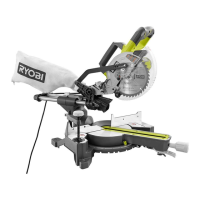
Do you have a question about the Ryobi TSS701 and is the answer not in the manual?
| Type | Sliding Compound Miter Saw |
|---|---|
| Voltage | 120V |
| Blade Diameter | 10 inches |
| Motor Power | 15 Amp |
| Bevel Capacity | 0-45° |
| Arbor Size | 5/8 inches |
| Amperage | 15 amps |
| Power Source | Corded Electric |
Essential practices for safe tool operation and handling.
Guidelines for a safe work area and personal protective equipment.
Precautions for electrical connections, extension cords, and avoiding shock hazards.
Rules for securing workpieces and safe blade operation.
Procedures for safe cutting setup, tool condition, and accessory use.
Warnings against kickback and improper tool usage.
Safety measures regarding blade path, tool movement, and motor switch operation.
Procedures for checking tool integrity and work area conditions.
Guidelines for safe saw operation, material cutting, and transport.
Explains signal words indicating risk levels associated with the product.
Defines common symbols and their meanings for safe tool operation.
Explains symbols related to electrical units and measurements.
Explanation of double insulation as a safety feature in electric power tools.
Details on connecting the tool to the correct power supply (120V AC).
Recommendations and warnings for selecting and using extension cords safely.
Definitions of terms related to cutting operations and saw components.
Definitions of terms related to materials, measurements, and tool parts.
Lists key technical specifications and cutting capacities of the miter saw.
Identifies and labels the main components and controls of the miter saw.
Explains how to lock the saw arm and use the carrying handle for transport.
Details on using the depth stop and the detent override mechanism.
Features for quick stopping and blade guidance illumination.
Controls for setting and locking miter angles and identifying positive stops.
Mechanisms for blade guarding, sliding, and spindle locking.
Lists the tools required for making adjustments and installations.
Lists the items included with the tool package.
Steps for unpacking, inspecting, and preparing the saw for assembly.
Critical safety warnings to follow before and during the assembly process.
Instructions and safety precautions for mounting the saw to a workbench or stand.
How to use the depth stop to control cut depth for dadoes and non-through cuts.
Information on attaching and using the dust bag for dust collection.
Details on the included blade wrench and its storage.
Instructions for installing and using the work clamp to secure workpieces.
Step-by-step guide for installing or replacing the saw blade.
Critical safety warnings and cautions for proper blade mounting.
Instructions for removing and reinstalling the throat plate, with safety warnings.
How to adjust the support foot for stability during sliding cuts.
Steps to align the saw blade parallel to the fence for accurate cuts.
Procedures to ensure the blade is perpendicular to the miter table for precise cuts.
Core safety principles to follow during all operations.
Lists the intended applications and materials for cutting with the saw.
Essential checks before starting any cutting operation to ensure safety.
Emphasizes securing the slide lock knob for non-sliding cuts.
Steps for setting miter and cross cut angles on the table.
Instructions for setting the bevel angle for precise cuts.
Guide to making compound miter cuts by setting both miter and bevel angles.
Importance and method of using supports for long workpieces.
Instructions for performing slide cuts and safety precautions.
Guide for attaching an auxiliary fence for specific cutting tasks.
Provides a chart of compound angle settings for popular structures.
Techniques for accurately cutting crown molding using compound miter settings.
Method for laying crown molding flat on the miter table for precise cuts.
Technique for nesting crown molding against the fence for cutting.
Instructions for cutting base molding vertically against the miter fence.
Guidelines for positioning warped material to prevent kickback.
Method for clamping wide workpieces for stable cutting.
How to adjust positive stops for precise angle settings.
Step-by-step guide for replacing worn motor brushes.
Guidelines for general cleaning, material compatibility, and lubrication.
